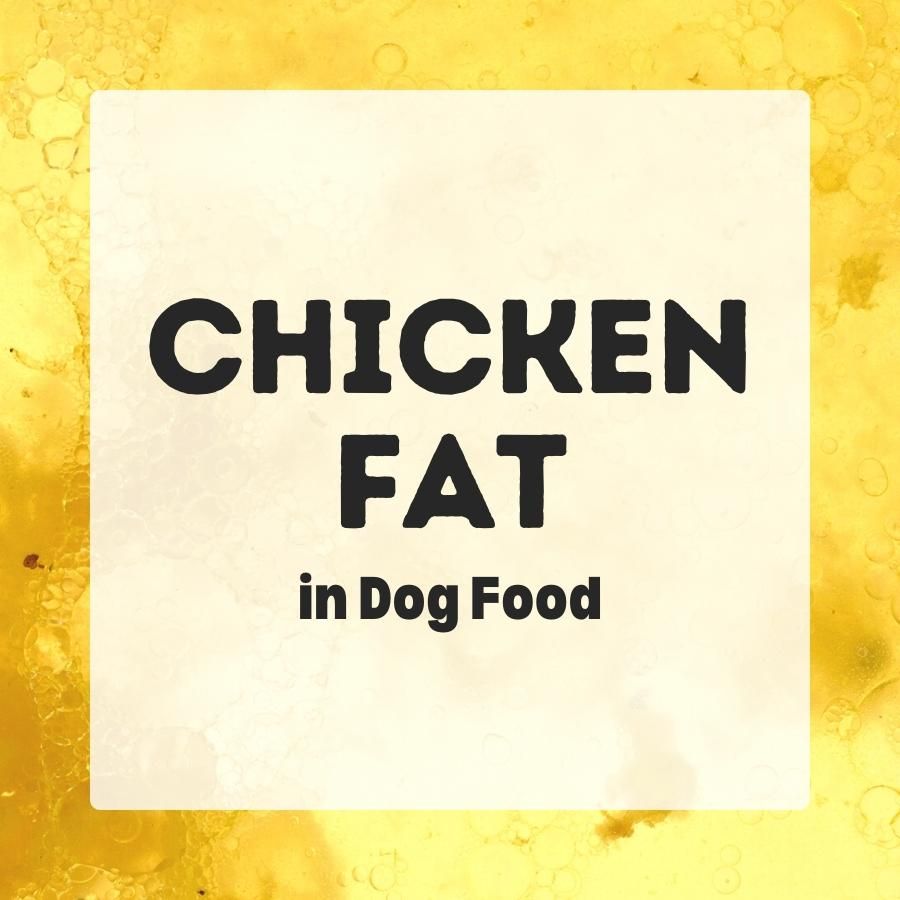In this article, you’ll learn how chicken fat in dog food is made, and about its purpose in your dog’s food.
Contents
What is Chicken Fat?
Chicken fat is a common ingredient found in many dog foods.
Beef fat is the main animal fat ingredient used in pet foods […], followed by animal fat ingredients and chicken fat […]
Pet Food Production and Ingredient Analysis 2020[1]
It is a type of animal fat that is derived from the rendering process of chicken raw materials.
During rendering, chicken raw materials such as the skin, flesh, bones, viscera, and other tissues are ground, heated, pressed and drained to separate fat from protein and minerals.
The melted fat is then filtered and centrifuged to remove most of the impurities and produce chicken fat to be used for pet food.
The quality of chicken fat can vary depending on many factors such as the composition of the raw materials, the feed used to raise the chickens used, or the rendering method.
But in summary, chicken fat is a purified source of fat produced from the rendering process of chicken raw materials.
Chicken Fat in Dog Foods
Chicken fat has become a very popular source of fat in pet food.
Manufacturers can choose between different qualities. But overall it is a very nutritious ingredient, rich in omega-6 fatty acids.
According to the AAFCO guidelines, chicken fat has to contain at least 90% total fatty acids, less than 1% insoluble impurities, and less than 2.5% of unsaponifiable matter[2].
The term unsaponifiable matter is a soap industry term that refers to all the components dissolved in fats that fail to form soap.
It’s a measure of all the stuff that is not fat like oil-soluble vitamins such as tocopherols, sterols, carotenoids, and other phenolic compounds or pigments, but also contaminants.
Chicken fat is a purified and safe ingredient. A 2002 study indeed only detected about 0.5% of unsaponifiable matter and 0.05% of insoluble impurities in pet food-grade poultry fat[6].
Overall, chicken fat is a natural source of energy and provides essential fatty acids. In dry dog foods, fats are often applied by spray-coating the finished kibble to provide flavor and shine.
Fat in dog and cat diets is used to support the energy needs of the animal, meet its essential fatty acid requirements, aid absorption of fat soluble vitamins, impart flavor, aroma, and texture to the product, and enhance product appearance.
USA Poultry Meal: Quality Issues And Concerns In Pet Foods 2007[3]
In general, it is believed that animal fats like chicken fat are more species appropriate for dogs than vegetable oils.
Pet food-grade poultry fats are very high in oleic acid, and contain lots of palmitic acid and linoleic acid[6].
As a rich source of linoleic acid, a polyunsaturated omega-6 fatty acid, chicken fat is often combined with sources of omega-3 fatty acids to balance the ratio of these fatty acids in dog food.
Chicken fat also contains natural vitamin E as well as choline, a vitamin-like essential nutrient[7].
| Nutrients in 100g[7] | |
|---|---|
| Energy | 900 kcal |
| Fatty Acids | |
| Saturated Fatty Acids | 29.8 g |
| – Palmitic acid | 21.6 g |
| Monounsaturated Fatty Acids | 44.7 g |
| – Oleic acid | 37.3 g |
| Polyunsaturated Fatty Acids | 20.9 g |
| – Linoleic acid | 19.5 g |
| Other | |
| Cholesterol | 85 mg |
| Vitamin E | 2.7 mg |
| Choline | 122 mg |
But like any fat high in polyunsaturated fatty acids, it is susceptible to rancidity. This is an irreversible chemical process that over time significantly lowers a fat’s nutritive value and palatability.
To delay the onset of oxidation, many suppliers and dog food manufacturers use antioxidants to stabilize chicken fat.
The traditional choice would be synthetic preservatives such as BHT and BHA or ethoxyquin. But today, these are not exactly popular among dog owners…
So more and more dog food manufacturers switch to more label-friendly “natural” preservatives such as mixed tocopherols.
Does Chicken Fat Cause Allergies?
Chicken fat is a highly purified ingredient. After rendering, it gets filtered and centrifuged to remove most impurities.
It contains very little, if any, chicken protein.
And the majority of dogs with chicken allergies are actually allergic to chicken protein, not chicken fat.
So in general, chicken fat is considered a safe ingredient for dogs, including those with chicken allergies.
But manufacturers usually don’t explicitly guarantee the total removal of proteins and peptides. And cross-contamination may occur if chicken proteins are processed in the same facilities.
In summary, while it is possible for dogs with chicken allergies to have an allergic reaction to chicken fat, it is very unlikely.
But if your dog has a known allergy to chicken, we recommend you talk to your veterinarian before feeding a diet with chicken fat.
Further Reading
[1] Pet Food Production and Ingredient Analysis (PDF). 2020. Institute for Feed Education and Research (IFEEDER), North American Renderers Association (NARA), Pet Food Institute (PFI)
[2] AAFCO Official Publication. Chapter 6. Free Access.
[3] Aldrich. USA Poultry Meal: Quality Issues And Concerns In Pet Foods. 2007.
[4] Aldrich: Rendered Products in Pet Food. Published in Essential Rendering (pdf). 2006.
[5] Kirkland & Fuller. The Effect of Ethoxyquin on the Chemical and Nutritional Changes of Poultry By-Product Meal and Poultry Offal Fat During Storage. Poultry Science. 1971. https://doi.org/10.3382/ps.0500137
[6] Pesti et al. A comparison of eight grades of fat as broiler feed ingredients. Poult Sci. 2002. https://doi.org/10.1093/ps/81.3.382
[7] U.S. Department of Agriculture. Agricultural Research Service. FoodData Central. 2019. fdc.nal.usda.gov
